Growth Outlook Improves Despite Persistent Global Risk
The first estimate of growth in real gross domestic product (GDP) during the third quarter came in two-tenths higher than our October forecast. We expected overall growth to be hit by an inventory drawdown from the General Motors strike and general weakness in the manufacturing sector; instead, unexpectedly strong net exports and government spending combined with a buildup in inventories helped to push GDP growth to a 1.9 percent annualized pace. Personal consumption expenditures (PCE) and government spending continued to be the largest contributors to growth. The anticipated drawdown in inventories should materialize in the fourth quarter, and we expect that PCE growth will continue to moderate and the trade deficit will widen; as a result, we have revised downward our forecast of annualized GDP growth in the final quarter of the year to 1.6 percent. Weaker growth in the fourth quarter means that our top-line forecast for full-year 2019 growth edged down slightly to 2.1 percent.
Looking ahead to 2020, effects from the Budget Act of 2019 and a temporary reprieve from trade tensions should help propel growth in the early part of the year. With trade tensions easing, stimulative fiscal policies, and continued consumer spending, we have revised upward our forecast of business investment next year, and as a result our full-year 2020 GDP forecast increased two-tenths to 1.9 percent. However, trade negotiations over the past two years have been highly volatile and another breakdown of talks remains a key downside risk to growth. Additionally, persistent weakness in manufacturing and political uncertainty across the globe—including Brexit-driven elections in the United Kingdom and political turmoil in Hong Kong and South America—continue to present risks to growth in the U.S. and could weigh on our forecast.
The housing sector, for several quarters a drag on the overall economy, has become a contributor, with residential fixed investment growing in the third quarter by a strong 5.1 percent annualized pace amid positive contributions from single-family housing construction, home improvements, and brokers fees. We expect momentum to carry forward with moderate growth in construction activity and sales, although housing market activity will continue to be held back by persistent supply constraints.
Global Uncertainties Remain, But Bar for Another Rate Cut Is High
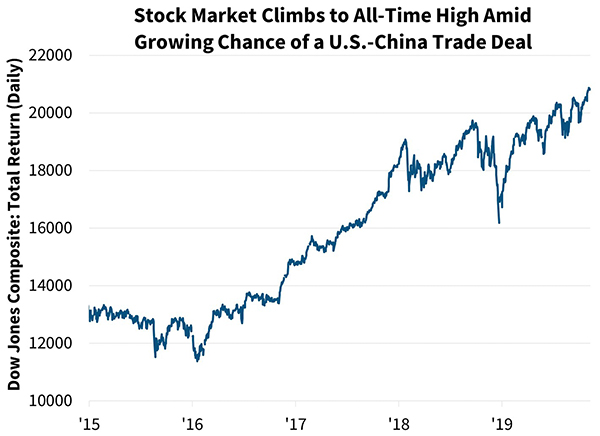
The "Phase One" trade deal between the U.S. and China has dominated media headlines and market sentiment since early October. Recent negotiations resulted in the U.S. cancelling a tariff hike on $250 billion of Chinese goods scheduled for October 15, and our expectation that the final deal will likely see the U.S. scrap tariffs scheduled for December 15 as well. In return, China has begun buying more American agricultural products and is considering removing restrictions on U.S. poultry imports that have been in effect since the beginning of 2015. The positive trade news over the past month helped send the stock market to fresh all-time highs, and the U.S. dollar weakened against the Chinese yuan to three-month lows before stabilizing as investors await new developments. Concrete details are important to the market, which has seen repeated attempts at trade negotiations fail over the past year and remains wary of another derailment. While we believe Sino-American trade tensions will ease in the short run, a comprehensive trade deal is unlikely given the broad range of disagreements between the two nations; we therefore continue to expect uncertainty surrounding trade policy to weigh on growth.
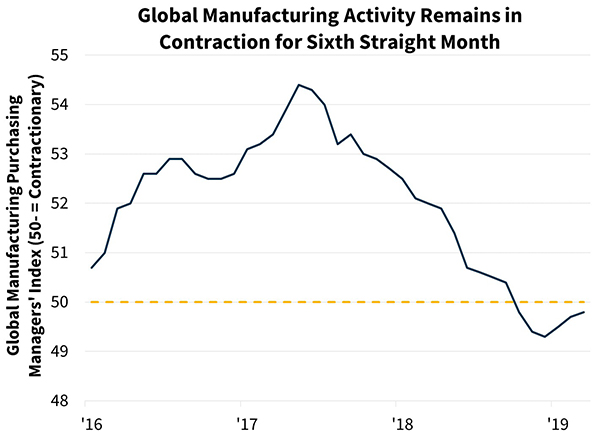
Other global uncertainties persist as well. In the United Kingdom, despite agreement by Parliament to a Brexit deal, the October 31 deadline to leave the E.U. was postponed to the end of January, prompting Prime Minister Boris Johnson to call a general election in the hope of gaining a majority favorable to his Brexit plan. Elections are scheduled for mid-December, and it seems increasingly likely that PM Johnson will gain the majority that he seeks, increasing the odds that the U.K. will leave the E.U. by the latest deadline. While the U.K.’s ability to execute Brexit successfully remains dubious, an end to the Brexit saga could help boost growth in a country that saw its economy grow in the third quarter at the slowest annual rate in nearly a decade. Elsewhere, protests in Hong Kong that have troubled the territory for six straight months turned violent in early November, and the tensions show no signs of abating. Protests have also engulfed Chile and Bolivia, aggravating the political uncertainty plaguing much of South America. Finally, the Global Manufacturing Purchasing Managers’ Index (PMI) remained in contraction territory for the sixth consecutive month in October, signaling a continued deterioration of business conditions. The current downturn in the index is the longest and deepest in seven years.
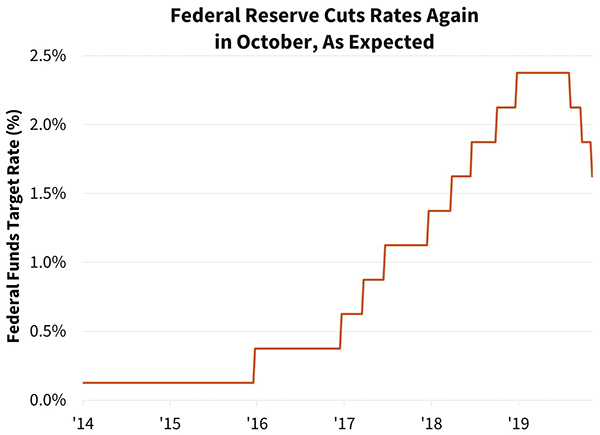
At its October meeting the Federal Open Market Committee (FOMC)—which has increasingly mentioned global events as well as domestic developments in explaining monetary policy decisions—lowered the federal funds rate target by 25 basis points to a range of 1.50 percent to 1.75 percent, as we expected. The FOMC's statement and Chairman Powell's comments during the post-meeting press conference suggested that the current cycle of rate cuts may have run its course and fed funds futures now indicate virtually no chance of a cut in December. However, Chairman Powell also emphasized that inflation expectations are "central" to the FOMC's decision making, and the Fed's preferred inflation measures have persisted below the "symmetric" 2.0 percent target. Any further rate cut will be dependent on incoming data regarding macroeconomic conditions, international developments, and inflation expectations. While most macroeconomic data seem positive for now, given what we regard as the low probability of a favorable, lasting trade resolution, as well as muted inflation and the range of international concerns mentioned above, we maintain our expectation that the FOMC will implement one further rate cut in early 2020 before pausing for the remainder of the year.
Consumers Supported by an Impressive Labor Market
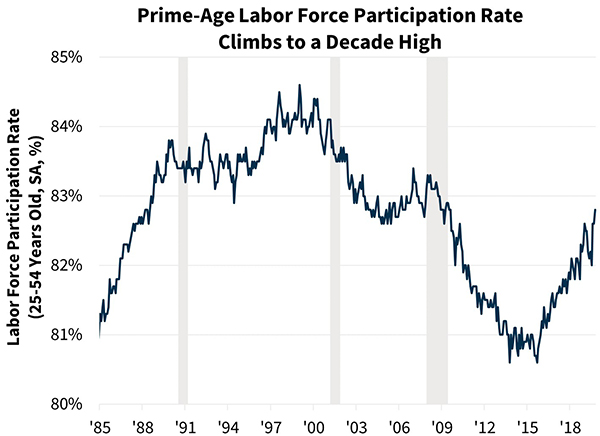
Nonfarm payrolls increased by 128,000 in October, a relatively strong number, especially since it included significant but temporary job losses from the resolved General Motors strike, as well as layoffs of temporary Census workers. In addition, job gains for the prior two months were revised upward by a total of 95,000. The unemployment rate remained at historically low levels, with a slight uptick reflecting an increase in the labor force participation rate as workers continued to return from the sidelines. In fact, the labor force participation rate of prime age workers (25- to 54-years old) rose in October to 82.8 percent, the highest level in more than a decade. In the last expansion prior to the Great Recession the prime age participation rate peaked at 83.7, suggesting that there is still room to grow. Other positives included the average workweek holding steady and average hourly earnings growth continuing at 3.0 percent year over year, offsetting concerns that growth in personal income might weaken.
Given the strong continued growth of employment and earnings, we maintain our expectation that consumer spending will support the economy throughout our forecast horizon with growth at or above 2.0 percent. As consumer strength continues, businesses will have to increase investment expenditures in order to meet the sustained demand, so our view of business fixed investment (BFI) has improved for 2020.
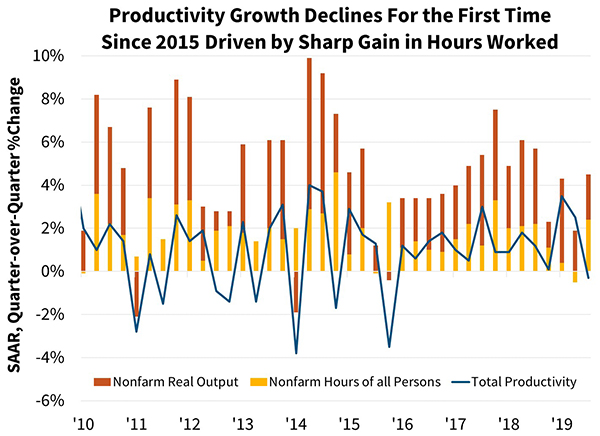
There remain downside risks to our forecast of increased business investment, however. Nonfarm business productivity declined in the third quarter for the first time since the end of 2015, and a sustained decline in productivity would reduce the incentive for increased BFI. However, the third-quarter decline was driven by a strong increase in hours worked, which rebounded from a decline in the second quarter to the fastest annualized pace since the fourth quarter of 2017. In our view the second-quarter decline in hours worked was a one-off event and the third-quarter decline in productivity will likewise be temporary as growth in both hours and output stabilize.
Weak business equipment investment is a key reason that we forecast continued lackluster BFI investment in the fourth quarter of this year. Banks responding to the Federal Reserve's Senior Loan Officer Opinion Survey (SLOOS) reported a decline in demand for commercial and industrial (C&I) loans in the three months ending in October, the fifth consecutive quarter of lower demand. Almost 90 percent of respondents cited decreased customer investment in plants or equipment as a somewhat or very important factor driving overall weakness in demand for C&I loans. Credit availability could present another obstacle to BFI growth in 2020, as SLOOS also reported tightening standards for C&I loans in the three months ending in October, making 2019 the first year to see tightening standards, on net, since 2016. Nevertheless, we believe this trend will reverse next year with businesses adding at least three-tenths to growth over 2020 compared to a likely zero percentage points this year.
Housing Becomes a Source of Strength Despite Continued Supply Constraints
Residential fixed investment (RFI) growth in the third quarter turned positive for the first time in seven quarters, as we forecasted. We expect momentum to carry forward into the fourth quarter, although the pace of RFI growth should decelerate somewhat to 3.3 percent amid more modest growth in home sales and housing starts.
Sales of existing homes fell in September, as we expected following two months of strong growth, declining 2.2 percent to an annualized rate of 5.38 million units. Even with that pull back, third quarter existing home sales came in at the fastest pace since the first quarter of 2018. In the near term we expect the pace of sales to increase as pending sales, which lead closings on average by 45 days, rose to a new 2019 high during September. Looking farther ahead, even though existing home sales have staged a strong recovery over the past year and lower mortgage rates coupled with relatively strong job growth continue to provide a supportive environment, we believe that existing home sales are likely nearing a plateau for three related reasons. First, the current sales pace is near a range that we believe to be consistent with recent decades' age-adjusted homeowner migration patterns, meaning that we do not expect to see additional "catch-up" migration following the relative market stasis earlier this decade. Second, and partly as a result, the availability of existing homes for sale continues to decline, limiting the potential for further growth. Third, persistent housing supply constraints continue to hold back household formation. Consistent with this view, purchase mortgage applications, while volatile in recent months, appear to be leveling off, and the Fannie Mae Home Purchase Sentiment Index (HPSI) has pulled back modestly over the past two months as fewer respondents believe that the available inventory makes this a good time to buy.
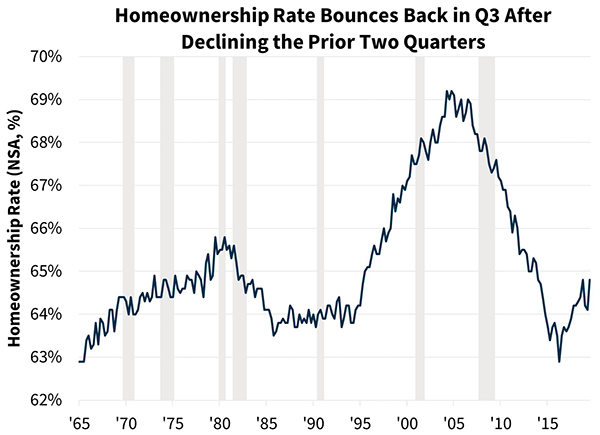
The market for new single-family housing also advanced in the third quarter: While sales of new homes pulled back slightly in September, for the quarter as a whole the sales pace hit 691,000 annualized units, the fastest of the economic expansion. The Census Bureau's Housing Vacancy and Homeownership Survey reflected this increase in new home sales, with the nationwide homeownership rate rebounding in the third quarter to 64.8 percent after declining during the first two quarters of the year.


More importantly, single-family construction activity provided several encouraging signs: starts rose to 901,000 annualized units for the quarter, the highest pace of the expansion; permits rose in September for the fifth consecutive month; and the Housing Market Index published by the National Association of Home Builders measured an improvement in homebuilder sentiment, increasing in October for the fourth consecutive month to the highest level since February 2018. Nevertheless, persistent labor and land constraints remain a barrier to adequate growth in supply, and much of the strength in new single-family home sales in recent months has come as homebuilders sold off excess inventories that accumulated during last year's sales slowdown. That process is now near an end, as the months' supply of inventory for sale at the current sales pace is back within its recent historical norm, and, going forward, we expect new home sales to level off for the time being as the pace of starts gradually catches up. We expect regional differences in market activity to reflect relative supply constraints, with new home sales likely to continue trending upward in the South while remaining subdued in much of the West and Northeast.
Consistent with growing sales over the third quarter, annual home price appreciation continued to firm after more than a year of decelerating growth. The S&P CoreLogic Case-Shiller Home Price Index inched up to 3.2 percent annual growth in August, from 3.1 percent in July, while the CoreLogic National House Price Index accelerated by two-tenths in September to a 3.5 percent annual increase. While home price growth remains relatively subdued compared to recent years, the end of decelerating price growth will dampen recent affordability gains driven by the lower mortgage rate environment.
Mortgage rates have stabilized recently after falling for ten straight months. The average 30-year fixed mortgage rate rose 8 basis points to 3.69 percent in October, though it remained over a full percentage point below year-ago levels, according to Freddie Mac. While mortgage rates are not expected to increase significantly in coming quarters, stabilizing rates will not provide the same support for home purchases that declining rates offered.
Multifamily housing starts fell 28 percent in September following a 41 percent surge in August and were down 6.9 percent for the third quarter as a whole. Multifamily construction starts tend to be volatile, however, and multifamily permits over the past two months have been among the highest readings since the past recession. We expect multifamily construction activity to remain quite strong in response to continued low vacancy rates, renter household formation, and low interest rates. For more information on multifamily market conditions please see the November 2019 Multifamily Market Commentary.
Modest upward revisions to our home sales expectations led to an increase in our forecast of purchase mortgage originations in 2019 and 2020 to $1.29 trillion and $1.30 trillion, respectively. Total originations for 2019 are expected to rise 16.6 percent from 2018 to $2.06 trillion. Looking ahead to 2020, we expect a decline in refinance activity and essentially flat purchase activity to bring down total originations by 9.2 percent to $1.87 trillion, with the refinance share dropping from 37 percent in 2019 to 31 percent in 2020.
Economic & Strategic Research (ESR) Group
(Data effective through November 12, 2019)
For a snapshot of macroeconomic and housing data between the monthly forecasts, please read ESR's Economic and Housing Weekly Notes.
Data source for charts: Dow Jones, J.P. Morgan, IHS Markit, Federal Reserve, Bureau of Labor Statistics, Census Bureau, Fannie Mae ESR Group.
Opinions, analyses, estimates, forecasts and other views of Fannie Mae's Economic & Strategic Research (ESR) Group included in these materials should not be construed as indicating Fannie Mae's business prospects or expected results, are based on a number of assumptions, and are subject to change without notice. How this information affects Fannie Mae will depend on many factors. Although the ESR group bases its opinions, analyses, estimates, forecasts and other views on information it considers reliable, it does not guarantee that the information provided in these materials is accurate, current or suitable for any particular purpose. Changes in the assumptions or the information underlying these views could produce materially different results. The analyses, opinions, estimates, forecasts and other views published by the ESR group represent the views of that group as of the date indicated and do not necessarily represent the views of Fannie Mae or its management.
ESR Macroeconomic Forecast Team
- Doug Duncan, SVP and Chief Economist
- Brad Case, Director
- Rebecca Meeker, Financial Economist
- Nick Embrey, Economist
- Mark Palim, VP and Deputy Chief Economist
- Eric Brescia, Economist
- Richard Goyette, Business Analyst
